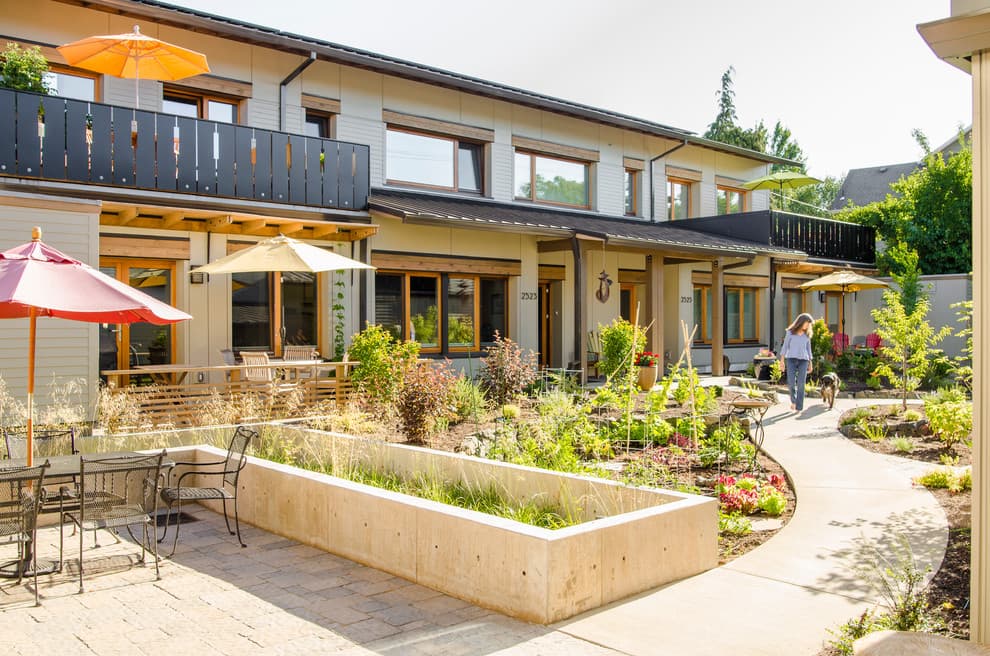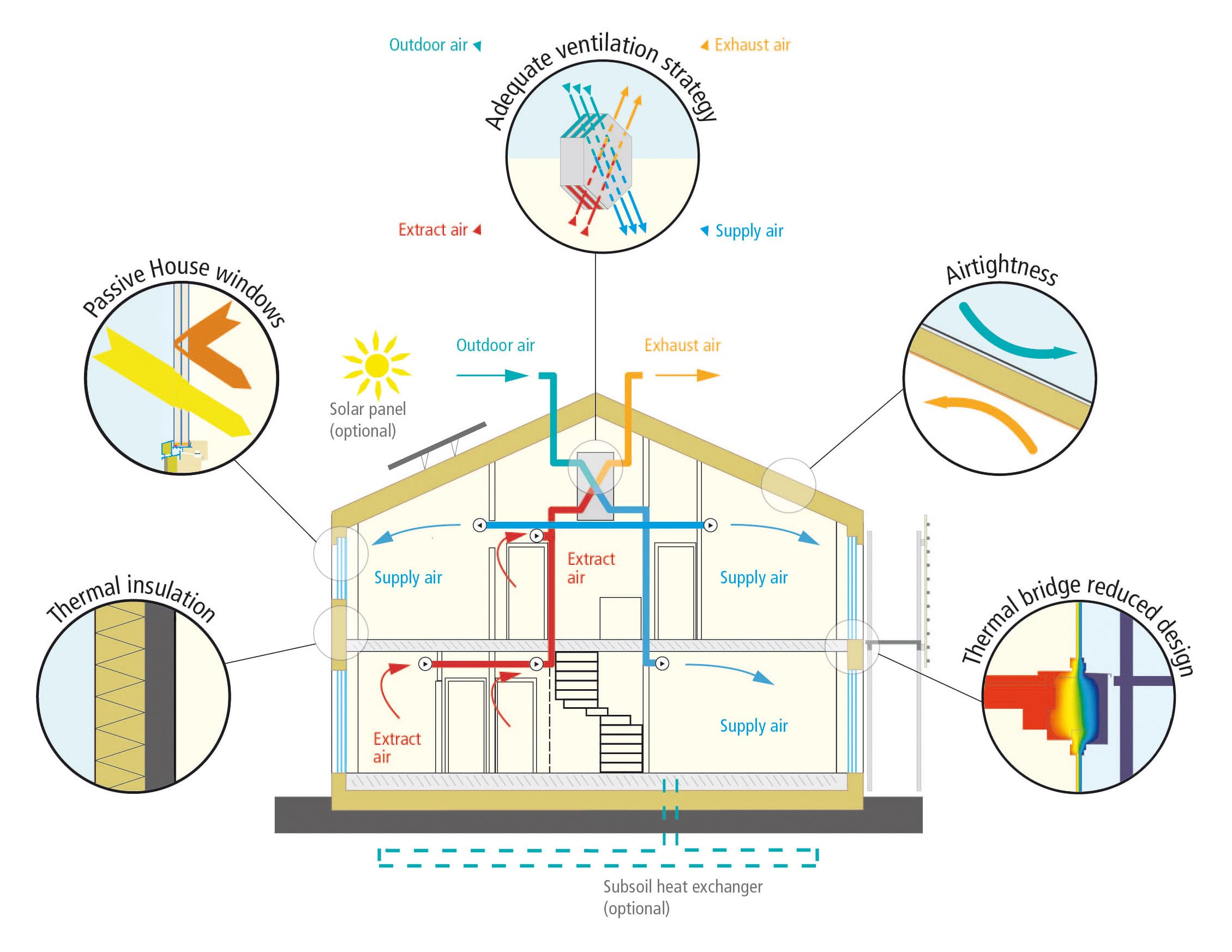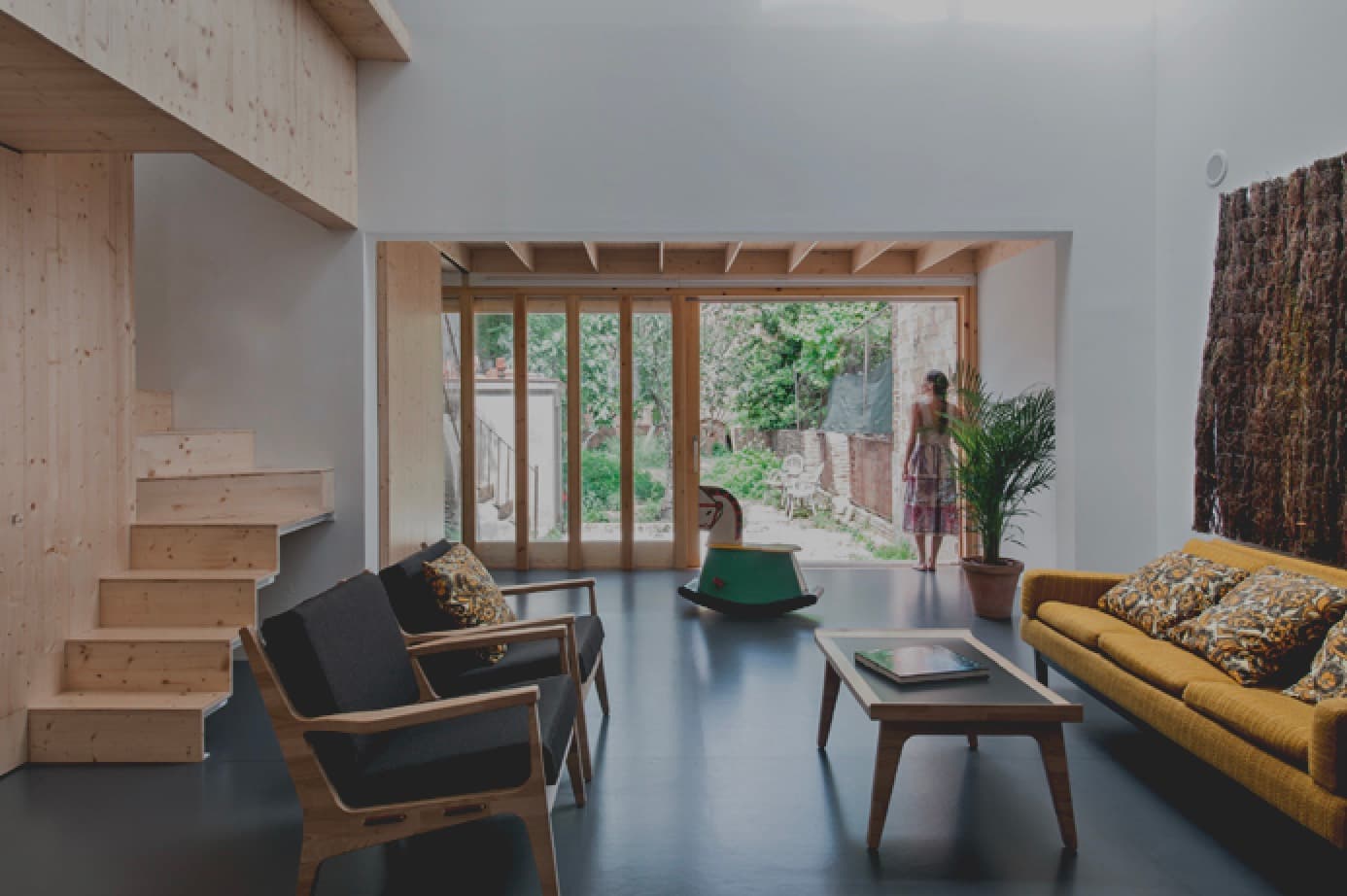Ankeny Row: Cohousing rehegua Oikohápe Oikohápekuéra Portland-pe

Across the United States, aging baby boomers find themselves living in houses that once accommodated growing families but now feel oversized, difficult to maintain, and environmentally inefficient. Dick ha Lavinia Benner, ojehu'ãva ko'ãga ko'ã mba'e, oikókuri Ankeny Row-pe—Peteĩ Passive House (PH) cohousing comunidad Portland, Oregon-pe, ohechauka cinco townhouses, peteĩ loft apartment, peteĩ comunidad hall, ha peteĩ jardín compartido. Hikuái omba'apo hikuái concepto guive, ojehecharamo heta ary, heta reunión, ha colaboración estratégica.
Finding the Right Location and Partners
Ankeny Row oĩ peteĩ vecindario histórico Portland-pe, ojehechaukáva transportación de tranvía rehe. Ojehecha'ỹre, ko'ã área ojehecha peteĩ decline ary 20-pe, ojehecha'ỹre automóviles ojehechaukáva, heta ary ohasava'ekue ojehecha revitalización, ohechauka mbopi resindencial ojehechaukáva ha retail de alta gama. Ary 2011-pe, Benners ha peteĩ pareja ohecha peteĩ 12,600 ft² (1,170 m²) sitio, ojehu'ãva Ankeny Row.
Los residentes fundadores ojehecha hikuái proyecto-pe:
- Ojehecha nueve firmas arquitectónicas térã diseño/construcción
- Ojerure tres finalistas oĩ hag̃ua design charrette-pe
- Oikuaa Green Hammer Design-Build ohechauka hikuái proyecto rembiapo ha experiencia Passive House
Ko'ã objetivo ojehecha'ỹre construcción típika, ojehecha hikuái:
- Minimizar impacto ambiental
- Crear residencias ojehechaukáva "aging in place" rehe
- Establecer peteĩ lugar de reunión social peteĩ comunidad ojehechaukáva.
Diseño Respetuoso al Clima en el Entorno Marino de Portland
El clima de Portland—invierno húmedo y templado, y verano soleado y templado—presenta similitudes con Europa Central, lo que hace que el estándar de Casa Pasiva sea teóricamente sencillo de implementar. Sin embargo, las diferencias en las prácticas de construcción y la disponibilidad de productos de construcción crearon desafíos de implementación que disminuyeron con la creciente experiencia de Green Hammer.
Para los arquitectos Daryl Rantis y Dylan Lamar, la preferencia de los clientes por un jardín en el patio central se convirtió en el principio organizador para todo el plan del sitio:
- Tres edificios dispuestos alrededor de un patio central
- Colocación estratégica de los edificios para maximizar la penetración de luz solar
- Un edificio con tres casas adosadas de dos pisos en la parte trasera
- Un segundo edificio con dos casas adosadas hacia el frente
- Un tercer edificio que alberga áreas comunes en el piso principal con un apartamento dúplex arriba
- Unidades de vivienda que varían de 865 a poco menos de 1,500 ft² (80–140 m²)
"Aha Moment": Oñemohendáva Net-Zero ohechauka hag̃ua Passive House
Peteĩ mba'e porã ojehecha mbopi hague design proceso-pe. Ohechauka hague, ohechakuaa hag̃ua Passive House estándar ha oñemohendáva hague comunidad-pe energía necesidad, umi residente rembiapo net-zero-energy (NZE) objetivo oikotevẽva ojehupyty hag̃ua peteĩ sistema fotovoltaico ohechauka hague menos de mokõi parte yvypóra oheja hague kuatiápe. Umi total PV sistema capacidad ha'e 29 kW.
Ko solución elegante ohechauka hague Passive House principios ha energía renovable generación—oipuru hag̃ua super-eficiente construcción diseño ohechauka hag̃ua energía renovable sistemas más práctico ha costo-efectivo.
Material Elecciones: Oñemohendáva Salud ha Sostenibilidad
Green Hammer rembiapo material Ankeny Row-pe ohechauka hague non-tóxico, sostenible opciones:
- Aproximadamente 90% umi construcción componentes ojejapo hague madera térã celulosa
- Forest Stewardship Council (FSC)-certificado madera ha terminado madera
- Durable metal techado
- Ojehecha hague limitado uso de espuma productos, principalmente en fundaciones
Ko fundación sistema ohechauka hague pragmatico compromiso—oipuru hague peteĩ insulated shallow fundación ohechauka hague peteĩ styrofoam "baño" ojehu hague concreto, ohechauka hague estratégico espesor variaciones yvypóra, interior footings, ha campo áreas entre footings.
Wall Assembly: High-Performance and Vapor-Open
Ankeny Row's wall assembly achieves an impressive R-value of approximately 50 through a thoughtfully engineered system:
- 2 × 6 inches (8 × 24 mm) structural framing (some walls use 2 × 4 framing)
- Structural plywood sheathing exterior to the framing (on the warm side of insulation)
- 9.5-inch (240 mm) wood I-joists furred out from the sheathing
- Dense-pack cellulose insulation filling the I-joist cavities
- Fiberglass mat gypsum sheathing on the exterior
- Diffusion-open membrane with taped seams forming air and weather-resistant barriers
This assembly allows vapor diffusion to both interior and exterior, avoiding moisture accumulation while maintaining exceptional thermal performance.
Air Barrier Continuity and Roof Design
The air barrier system demonstrates meticulous attention to detail:
- Taped membrane wraps continuously from foundation to roof
- Direct connection to the foundation's concrete edge (the air barrier at ground level)
- Monosloped wood trusses (28 inches/700 mm deep) filled with cellulose insulation
- Ventilation channel between trusses and metal roofing creating a vapor-open assembly
Diseño Solar Pasivo ha Temperatura Estacional
El diseño aprovecha la orientación solar mientras previene el sobrecalentamiento:
- Ventanas más grandes en fachadas orientadas al sur maximizan la ganancia de calor solar en invierno
- Aleros profundos dan sombra a las ventanas del piso superior orientadas al sur en verano
- Toldos protegen las ventanas del piso inferior y del suelo
- Detalles cuidadosos de elementos salientes (toldos, balcones) para minimizar el puente térmico
- Ventanas colocadas estratégicamente permiten ventilación cruzada y de apilamiento para el enfriamiento nocturno
- Ventiladores de techo en algunas unidades mejoran la comodidad con un uso mínimo de energía
Sistemas Mecánicos: Minimalistas pero Efectivos
Cada unidad cuenta con un conjunto cuidadosamente seleccionado de sistemas mecánicos:
- Ventilador de recuperación de calor individual que proporciona aire fresco continuo
- Bombas de calor mini-split para calefacción suplementaria y enfriamiento ocasional
- Calentadores de agua con bomba de calor instalados en cobertizos de almacenamiento al aire libre para evitar ruido mientras extraen calor del aire ambiente
- Electrodomésticos de primera categoría con calificación Energy Star
- Iluminación completamente fluorescente o LED
Se espera que las ganancias de calor solar e interno proporcionen el 67% de la demanda anual de calefacción, con los mini-splits manejando el resto.
Modeling Challenges and Real-World Energy Use
Using the Passive House Planning Package (PHPP) to simultaneously model three linked buildings presented challenges. Dylan Lamar's experience with Passive House projects in the Pacific Northwest allowed him to select assemblies that would meet annual heating and primary energy demand targets.
However, when sizing the PV system, Lamar had to deviate from PHPP defaults for plug loads and appliances. His observations provide interesting cultural insights:
- Even environmentally conscious American clients typically use more energy than PHPP default assumptions
- European Passive House occupants generally live within PHPP defaults
- For realistic modeling, Lamar incorporates clients' previous utility bills to estimate future non-heating/cooling energy use
Cost Considerations: Experience Reduces Premium
According to Lamar, the cost premium for building to Passive House standards represents a relatively small part of the overall project budget. As Green Hammer has gained experience and developed relationships with subcontractors familiar with Passive House construction methods, other factors—like finish selections and fixture choices—have greater impact on final costs than the high-performance envelope.
Passive House Metrics
Pe proyecto ohechauka números ijeroviaha:
- Heating energy: 1.37–2.09 kWh/ft²/year (14.76–22.46 kWh/m²/a)
- Cooling energy: 0.07–0.21 kWh/ft²/year (0.73–2.27 kWh/m²/a)
- Total source energy: 12.07–14.83 kWh/ft²/year (130–160 kWh/m²/a)
- Treated floor area: 1,312–3,965 ft² (122–368 m²)
- Air leakage: 0.5–1.0 ACH50
Ankeny Row ohechauka ko'ã mba'e: Passive House prinsipio kuéra ikatu ohechauka heta mba'e peteĩteĩme—omohendáva porã, energía-porã mba'ére, oikohápe umi oikóva ikatu oikóvo hína, omombarete henda rembiapo ha omboguerekóvo yvypóra rembiapo. Umi baby boomers oheka jey hína mba'erechaukaha porãva, ko proyecto Portland ohechauka mba'e porã umi técnica rembiapo ha umi social mba'ére.

Evolving Passive House Standards: Adapting to Climate and Context
Emoĩ porã Passive House estándar rehegua evolución, oúva 'Classic' modelo guive, péicha avei clima-specific certificaciones como PHIUS ha EnerPHit, ohechauka peteĩ mba'e porã oikotevẽva flexibilidad ha global aplicabilidad.

Aplicando los Principios de Casa Pasiva en Diferentes Climas
Emoañe'ẽ mba'éichapa Passive House mba'e porã oñemohendáva umi clima iñambuévape yvórape, oñembohasa umi mba'e porã ojehecha ha umi poranduhára práctico ohechauka hag̃ua mba'éichapa ikatu oikotevẽ komfort ha eficiencia peteĩ ambiente rupive.

Ñemokã Porãite: Óga Pasíva Ypykue
Eikuaa mba'ére ñemokã porãite tuichaitereípa óga pasívape guarã ha mba'éichapa oipytyvõ energía ñembyai'ỹre.